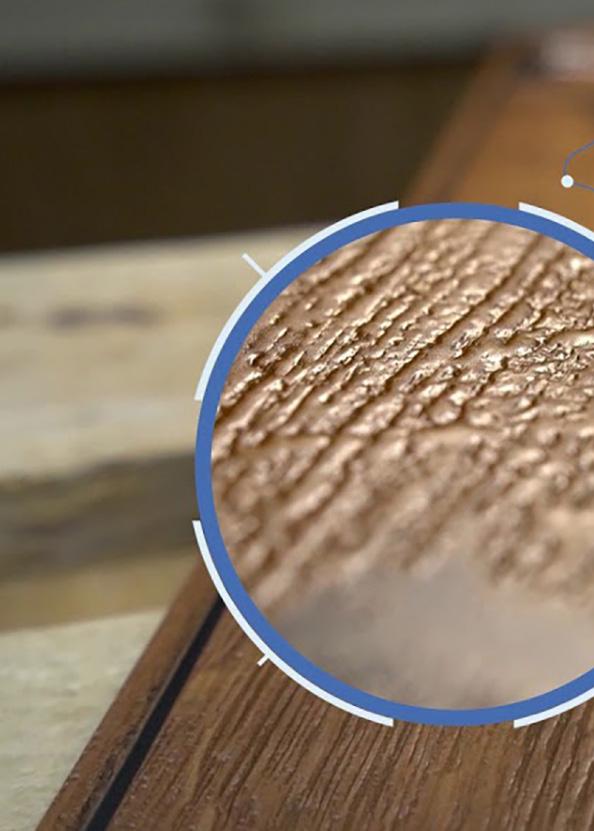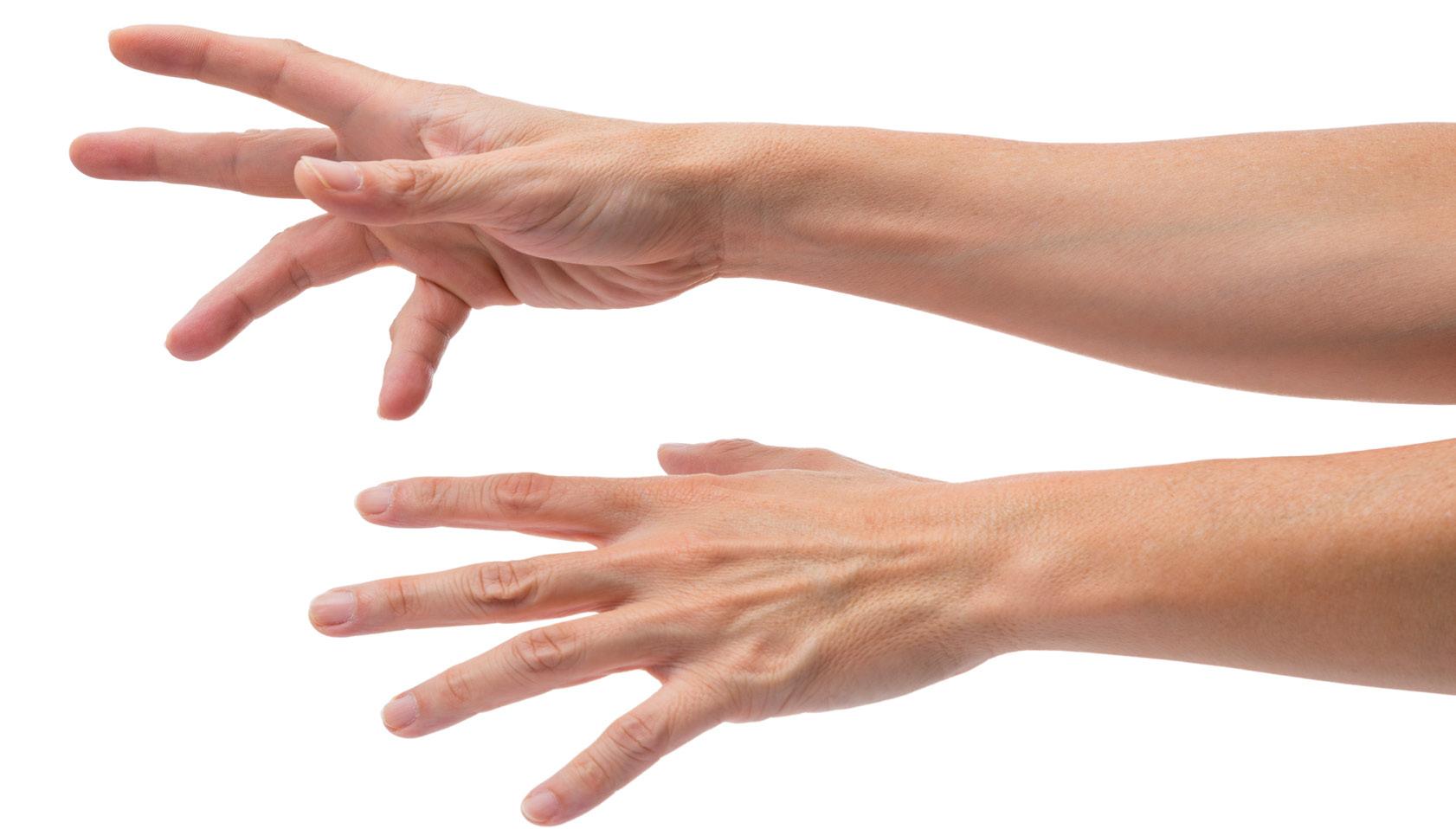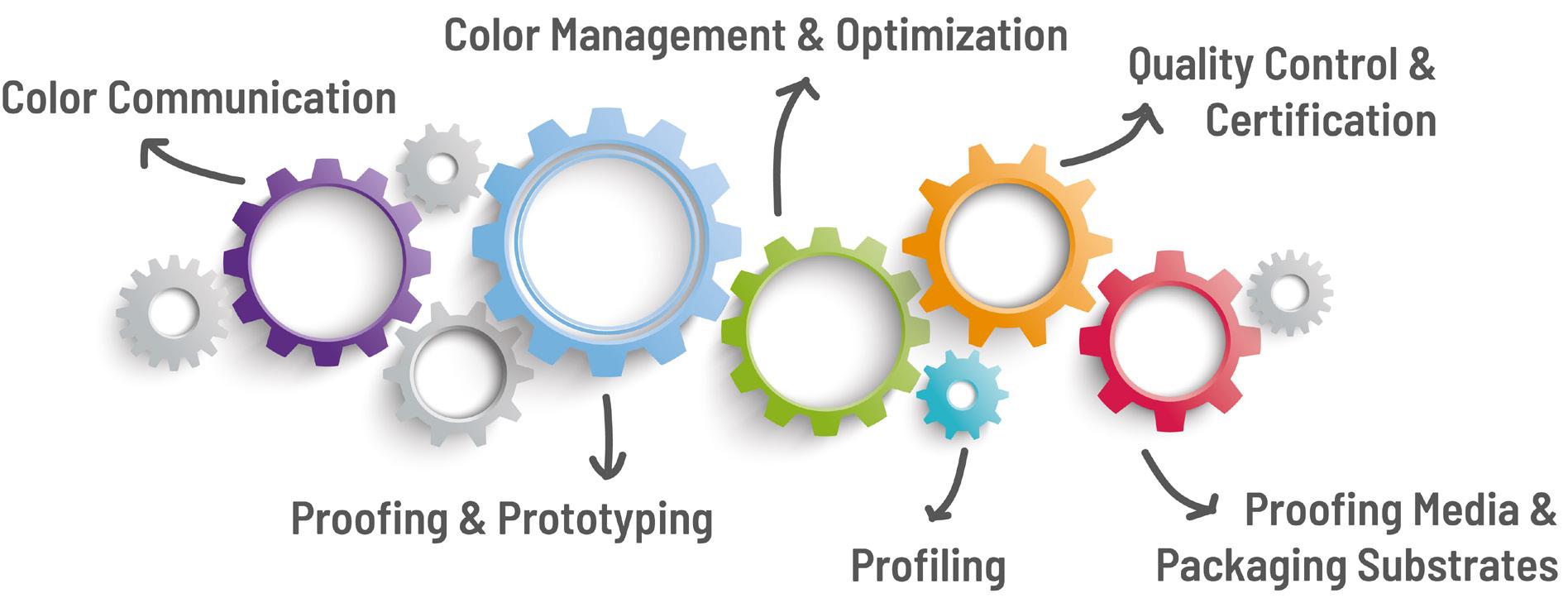
9 minute read
of all sizes and markets Woodworking surface decoration Digital horizons in reach?
Advertisement
For many years a range of industries have been using a variety of printing technologies to create decorative surfaces. From screen, offset and gravure printing, all have been used to create functional and decorative surfaces. In the past decade we have seen the rise in digital printing. Inkjet printing innovations in material science and innovation software along with other solutions have emerged in the market.
This article will focus on two key areas where industrial printing has a significant impact, digital décor paper for laminates and direct printing in the woodworking industry. We will explore the opportunity and technology that is driving this innovation to be adopted. A brief overview of surface decoration markets
The woodworking industry is an example of the vast use of decorative surfaces in a range of applications. While it has existed for thousands of years, today this segment is mainly influenced by the construction industry, where many of these materials are used in the building and renovating of homes and commercial buildings. A few key industry segments that dominate decorative printing in woodwork are flooring and decorative laminates.
Flooring as its own sub-industry is projected to reach $448 Billion by 2023, according to Markets and Markets research. About 23% of this value is concentrated in Europe. Decorative laminate is another segment that has massive uses, totalling over 11 Billion M2 printed today. Europe currently houses about 20% of the total decorative laminate volume produced.
Like other segments, manufacturers for products such as flooring and furniture, are looking to digital technologies as a means to meet growing needs by customers for more customised products. Successful implementation of digital printing allows these manufacturers to offer innovative solutions that not only offer short run production but also have a unique value proposition that commands a premium billing.
Recent research by Keypoint Intelligence indicates that digital printing is fast becoming a necessity. Client demands for devices capable of shorter print runs and faster turnarounds are growing (61% and 72%, respectively). Just-in-time manufacturing demand is also on the rise (59%), and personalisation (54%) is also seeing a sharp increase.
The expectation by clients for a fast turn-around and a higher degree of customisation is driving adoption of digital technologies.
The reality of consumer demand
When mass production first gained steam, it was all about speed and simplicity. For the first time in human history, a wide array of products could be created piecework by trained human hands and mechanised assistance. This lowered prices and increased availability of many items for the consumer market. Early industrialisation meant efficiency, availability and low cost per unit. As noted by Henry Ford in 1909: “Any customer can have a car painted any colour that he wants so long as it is black."
Fast-forward over a hundred years and technologies and client priorities have drastically changed. Mass customisation, once a pipedream, is now a hotly demanded capability, driven in part by expectations set by e-commerce, social networking and innovative technologies.
That said, there is another consumer demand that must be mentioned when discussing woodworking – and that is sustainability. Sustainability is a topic that makes more headlines every year as consumers (particularly younger generations like Millennials and Gen


Z) increasingly worry about the future of the planet. Consumers in these age groups want products that are ecofriendly and do not deplete the planets limited resources.
Digitally printed surface decoration as a differentiator
With these two factors rising to prominence, digitally printed surfaces in woodworking applications look to be a notable way for differentiated products going forward. Digital printing can address the growing needs for short run as well as the need for operational efficiencies in longer run printing as well. This makes it ideal for direct customer suppliers as well as impregnators (High Pressure Laminates manufacturers) who are looking for differentiated product offers.
Digital printing of decorated surfaces in woodworking industries brings new manufacturing efficiencies such as small batch manufacturing, reduce make ready, gravure cylinders preparation and the integration of digital solutions with current manufacturing lines (meaning companies do not have to completely re-invest in their workflow processes to see some benefits). Given that PSPs are also seeing increases in shorter run printing (61%) and justin- time manufacturing (59%), it shows that digital printing technology is suited to address the top three developing consumer demands that are impacting the market.
The Digital Advantage - Reshaping the supply chain
Decorative surfaces traditionally were decorated using spray painting or using conventional printing such as gravure printing. These typically needed long lead time as designs were developed and cylinder engraved ahead of final lamination onto surfaces. With minimum orders of about one ton in the case of décor papers these are limited to the circumference of the press impression cylinder.

Moreover, due to changeover time needed between jobs the number of jobs produces in a shift is limited. With digital printing, jobs can be produced to a specific length required by the client, as well as no longer being limited to the circumference of a cylinder, instead they can be produced to fit the size of the lamination press or the unique

pattern design in the case of direct printing.
Improving on natural materials
While natural wood brings an air of class to any project, it also comes with an established set of drawbacks. Apart from the sustainability aspect of natural wood, it may not be suitable for some applications where exposed to the elements or in close contact to humidity, or insects. In many cases we may also find products with mixed materials, however their decorative surface is uniform and they all look alike.
Digital printing technology, such as the decoration of rigid surfaces through direct printing or laminating, allows different material surfaces to mimic natural surfaces. This means, composite wood, metal, or vinyl (among others) can be printed in such a way that they resemble real wood in colour, texture, and pattern. That said – these substances can be stronger, more durable, and more water resistant than the real thing – giving consumers a product that satisfies every need in their woodworking expectations.
Technology impact
The woodworking industry offers opportunities for solutions aimed at custom short run work as well as massive production for high volume manufacturing. From flatbed inkjet printers to systems that can produce décor materials at a whopping speed of 150 meters per minute. New devices are being unveiled that can print to a wide variety of surfaces – from basic flooring to elaborate prints directly onto wooden doors and chairs. printers have been developing solutions that are suitable for woodworking. However, the woodworking space typically presents a challenge, as printing is part of a process that requires multiple steps for surface decoration. These steps require deep understanding of the supply chain, processes, materials and applications (e.g. flooring, cabinetry, furniture, lamination, impregnation) and several companies with woodworking heritage entered this space with digital solutions.
These include companies such as Hymmen with their Jupiter and Saturn product lines, Cefla Finishing J-Print product line, Barberan JetMaster as well as the Schattdecor Palis 750 a collaboration between décor paper manufacturer and Palis a developer of inkjet systems.
These offer a range of solutions for direct to surface printing that not only provide surface image – they also offer dimensional texturing that is in in sync with the image underneath it, whilst maintaining the permanency standards for the surface.
There are several technology providers in this space, some yield from the graphic arts industry and some are suppliers that developed solutions that are dedicated to woodworking applications. Some of the suppliers from the graphics arts space that are now migrating to industrial printing include companies such as Kodak with the Prosper line, Koenig & Bauer with their RotaJet product line, Inca with the Onset product line, as well as a new introduction by EFI with the Cubik product line.
Many others with flatbed UV printers as well as rolled aqueous based inkjet
Predictable production and quality assurance
Advancements in digital printing technology are not all about speed and increasing substrate variety. We have observed focus improvements in the area of quality assurance as well. Printing onto surfaces (whether natural or artificial) can be expensive and mistakes are costly – not to mention

a slowdown in production. Many new pieces of hardware are prioritising defect detection and classification, ensuring colour and texture consistency across the print run.
One interesting piece of innovation on this front is the use of digital twin technology. Digital twin is a virtual and a dynamic simulation of all process steps in a manufacturing line. With digital twin, companies can simulate all process steps for each tool, robotics and human interaction in real time. The digital twin can predict problems and breaks before they occur – letting the manufacturer address them before the physical production line is commissioned.
Digital twin is a technology that already impacts much of the manufacturing segments – and the woodworking industry is joining the wave as manufacturing processes in this segment are complex. Digital twin provides a new level of workflow, maintenance and reduce downtime. For example, new surface decoration lines with digital printers and other connected hardware.
Automation
All the solutions we noted thus far in this review are innovative and can produce a product quality that is consistent and will meet client demand for standard or customised products. However as with many manufacturing processes a clear understanding of production status, manufacturing line productivity and the profitability of the creation are critical. To aid manufacturers, we now have solutions that are dubbed ‘Industry 4.0’ ready. These solutions use digital toolset in the planning, development as well as monitoring production and uptime of the fully integrated line.

These solutions may initiate the planning process using a Digital Twin simulation of the production line and its operation created before the line is built. After full debugging, this digital plan is turned into a fully integrated and assembled line. The digital cloud-based infrastructure used in the Digital Twin is now used to track live production and monitor key performance indicators (KPI).
Woodworking has traditionally been one of the smaller printing industries, restricted by a lack of consumer interest. This disinterest can be at least partially attributed to a lack of customisation, as well as the time/costs involved in creating any personalised product. With technology advancements and digital printing in woodworking becoming more common, some of the barriers in this industry are becoming relaxed. Once customers see that they can express themselves in wood without breaking the bank, this industry may experience new growth.
Given the realities of the market – a focus on mass customisation and a growing demand for sustainability, it is difficult not to see digital printing becoming more vital in woodworking. We expect to see continued growth in the woodworking industry as a whole – including categories like furniture – as digital printing moves closer toward becoming the standard.











